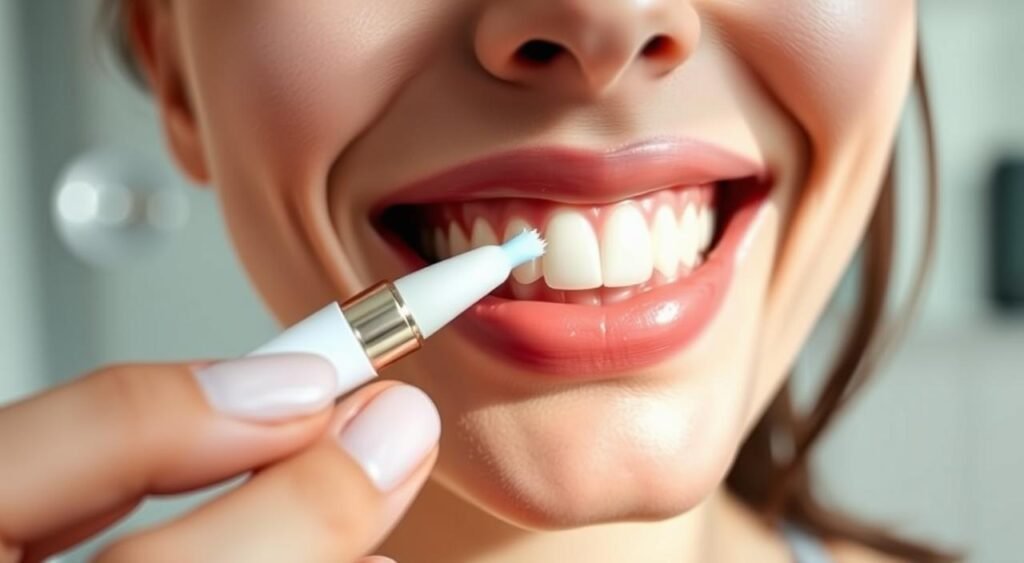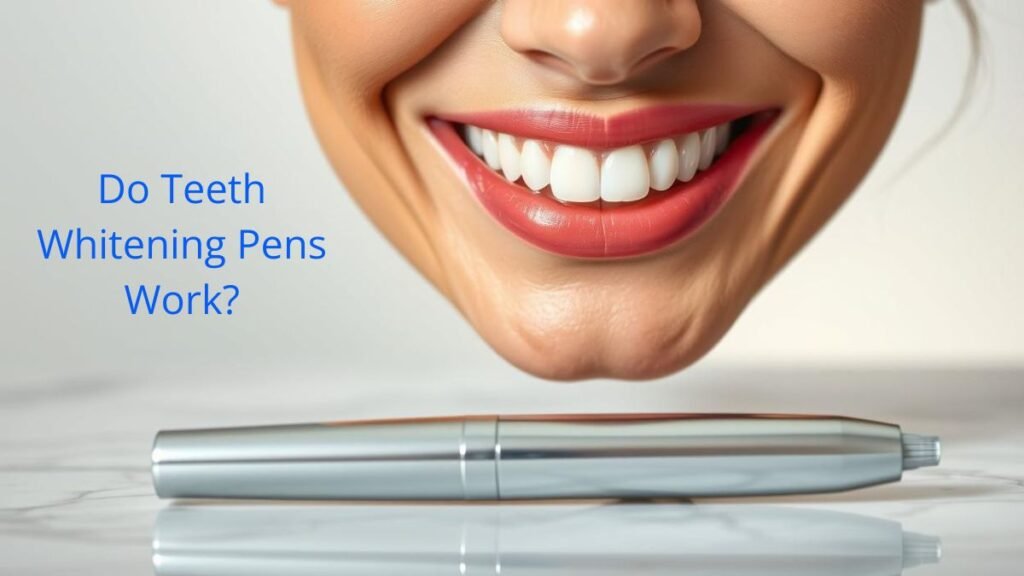Ever caught yourself wondering if that tiny pen-like device could truly transform your smile? You’re not alone. Teeth whitening pens have become a popular choice for those seeking a brighter smile, but do teeth whitening pens work and really deliver on their promises?
Teeth whitening pens offer a convenient way to whiten your teeth at home. These pocket-sized whitening products contain a peroxide-based gel that targets surface stains. With their easy-to-use applicator, you can apply the whitening solution directly to your teeth, even reaching those tricky spots.
While teeth whitening pens are affordable and simple to use, their effectiveness varies. Some users see noticeable results within a week, while others may need several weeks of consistent use. The outcome often depends on the severity of your tooth discoloration and the strength of the whitening gel.
As you explore options to brighten your smile, keep in mind that teeth whitening pens are just one of many whitening products available. From professional treatments to over-the-counter solutions, each method has its pros and cons. Let’s dive deeper into the world of teeth whitening pens and uncover the truth about their effectiveness.
Understanding Teeth Whitening Pens
Teeth whitening pens are popular for their convenience. They are small, easy to use, and perfect for a quick smile brightening on the go.
What are teeth whitening pens?
A teeth whitening pen looks like a pen but is filled with whitening solution. It’s made for easy use and is great for quick touch-ups or maintenance.
How do teeth whitening pens work?
These pens apply a serum to your teeth. The serum has bleaching agents that remove stains, making your teeth look brighter. You don’t need to brush or rinse after using them.
Active ingredients in whitening pens
The main ingredients in these pens are bleaching agents. These are usually hydrogen peroxide or carbamide peroxide. Most pens have six to nine percent hydrogen peroxide.
- Hydrogen peroxide is the primary bleaching agent
- Carbamide peroxide breaks down into hydrogen peroxide
- Higher concentrations are found in professional whitening systems
Teeth whitening pens are convenient but might not cover all teeth surfaces. A study showed that users could only cover about 85 percent of their teeth. Always talk to your dentist before starting any whitening treatment.
The Science Behind Teeth Whitening Pens
Teeth whitening is a popular dental procedure. Many people want whiter teeth to feel more confident and look better. Whitening pens are a convenient way to get this done. Let’s look at how these pens work to brighten your smile.
Bleaching Agents in Action
Teeth whitening pens use hydrogen peroxide or carbamide peroxide. These chemicals break down stains on your teeth. When you apply them, they go into the enamel and start an oxidation process.
This process targets the colored compounds, making your teeth look brighter.
The Whitening Process
As the bleaching agents work, they remove stains from food, drinks, and smoking. The peroxide breaks down into oxygen molecules. These molecules then change the discolored molecules in your teeth.
This change makes your teeth appear whiter.
What to Expect
Results from teeth whitening pens vary based on several factors:
- Severity of stains
- Frequency of use
- Concentration of bleaching agent
You might see mild improvements in just a few days. For more noticeable changes, consistent use over several weeks is often needed. Remember, while whitening pens can lighten teeth by one or two shades, they may not match the results of professional treatments.
Do Teeth Whitening Pens Work?
Teeth whitening pens can make your smile brighter, but how much depends on several things. Many people see a difference after using them regularly. Yet, they’re better for small improvements, not big changes.
It’s key to know what these pens can and can’t do. They work best on teeth that are naturally white and not too stained. If you have crowns, veneers, or braces, you might not see much difference.
To get the best results, use the pens twice a day as part of your oral care. Some products let you apply them more than once a day. The active ingredient, peroxide, slowly breaks down stains.
Using whitening pens can lead to noticeable changes, but they’re often small. For bigger changes, professional treatments like laser whitening are faster and more effective. They can make a big difference in just one visit.
Good oral hygiene is essential for a bright smile. Brushing, flossing, and dental visits are important. Whitening pens can help, but they’re part of a bigger oral care plan.
Pros and Cons of Using Teeth Whitening Pens
Teeth whitening pens are a handy way to brighten your smile. Many reviews praise their ease and affordability. Let’s look at their benefits, drawbacks, and safety.
Advantages of Teeth Whitening Pens
These pens are easy to carry and use. They’re great for people with busy lives. They’re also cheap, with most pens lasting up to 35 nights.
Limitations and Possible Drawbacks
Teeth whitening pens are not perfect. They work best on stains from coffee, tea, and wine. But, they might not tackle deep stains. Results last 6 months to a year, depending on how well you care for your teeth.
Safety Considerations and Side Effects
Are teeth whitening pens safe? They’re usually safe if used right. But, using them too much can hurt your teeth and gums. Sensitivity can last a day or two.
It’s important to follow the instructions and not use them too much. If you’re pregnant, have sensitive teeth, or gum disease, talk to your dentist first.
Keep in mind, whitening pens are a quick fix. For lasting results, think about professional treatments or dental work like crowns or veneers.

Alternatives to Teeth Whitening Pens
Teeth whitening pens are just one option for a brighter smile. Let’s look at other ways to get that pearly white glow.
Professional Whitening Treatments
Professional whitening gives strong results. Dentists use strong whitening agents for quick results. Philips Zoom Whitening, for example, can brighten teeth in just 15 days with daily use.
These treatments often work faster than home options.
Over-the-Counter Products
When comparing whitening pens vs strips, both have good points. Crest 3D Whitestrips Professional Effects can lighten teeth by two to four shades in 20 days. Zimba Teeth Whitening Strips can make teeth nearly three shades whiter in two weeks.
For a quicker option, Crest 3D Whitestrips 1 Hour Express + LED Kit can whiten teeth an average of 2.6 shades in 19 days.
Natural Teeth Whitening Methods
Natural teeth whitening pens and gentle options are for those wanting a holistic approach. The Tarte Pearly Girl whitening pen helps keep teeth bright. Also, using whitening toothpaste like Colgate Optic White Renewal can remove up to 10 years of yellow stains in four weeks.
- Maintain good oral hygiene
- Avoid staining foods and drinks
- Use whitening toothpaste regularly
With many choices, you can find the right whitening method for you. Whether it’s professional whitening, over-the-counter products, or natural methods, a brighter smile is possible.
Conclusion
Do teeth whitening pens work? The answer is not simple. These pens can be good for quick fixes and keeping your smile bright. They’re great for when you’re on the move, helping you brighten your teeth at work or parties.
They work by using hydrogen peroxide or carbamide peroxide to remove stains. But, they might not get rid of deeper stains. For the best results, use them as part of your daily oral care.
Teeth whitening pens are just one part of getting a brighter smile. They’re easy to use and save time, but they might not give you the best results. If you want a more dramatic change, you might need to try other methods or see your dentist.
The secret to a stunning smile is good oral care and regular dental visits. Plus, finding the right whitening method for you is key.
FAQ – Teeth Whitening Pens
What are teeth whitening pens?
Teeth whitening pens are small devices filled with a whitening formula. They let you apply a serum with bleaching agents like hydrogen peroxide or carbamide peroxide directly to your teeth.
How do teeth whitening pens work?
The active ingredients in whitening pens break down stains on your teeth. This gives your teeth a brighter look. You don’t need to brush or rinse after using them, making them easy for quick touch-ups.
What are the active ingredients in whitening pens?
Whitening pens use bleaching agents like hydrogen peroxide or carbamide peroxide. These agents help break down stains on tooth enamel.
Do teeth whitening pens work?
Teeth whitening pens can give short-term results and help keep your smile white. But, they might not work as well for more serious tooth discoloration.
What are the advantages of teeth whitening pens?
They are convenient, affordable, and easy to use. Plus, they are portable, making them great for use on-the-go.
What are the limitations of teeth whitening pens?
Their results don’t last long, and they might not apply evenly. They also don’t work well on deep stains.
Are teeth whitening pens safe?
They are generally safe but can cause tooth sensitivity and gum irritation. Always follow the instructions carefully. If you have sensitive teeth or dental work, talk to a dentist first.
What are alternatives to teeth whitening pens?
You can try professional teeth whitening, over-the-counter products like strips and LED light kits, or natural methods like whitening toothpaste.









2 Comments
Pingback: Whitening Teeth Cost: Affordable Smile Makeover Options
Pingback: How Long Does Teeth Whitening Take? Quick Guide